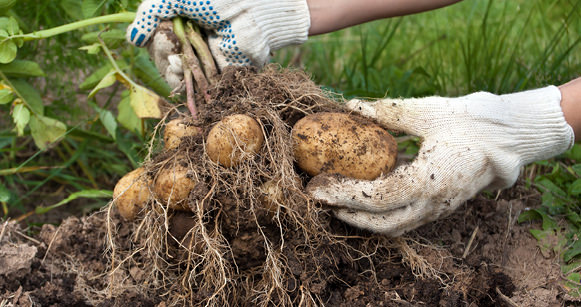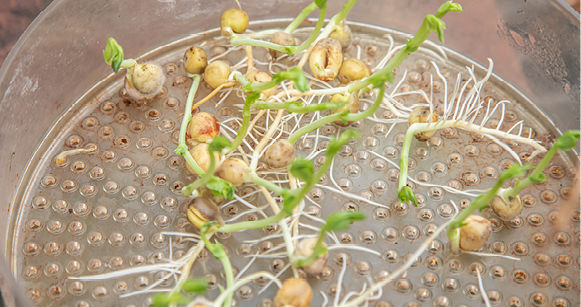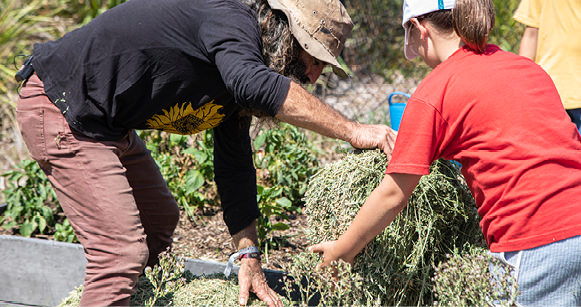LEARNING ACTIVITY
STORY
Now that Beth and her Junior Landcare group have created and prepared their food garden bed, they were keen to start planting, this was the activity their group was looking forward to the most. Her friend Eliza wanted to know how to choose the best fruit and vegetables to grow. Since Beth’s family spent a lot of time in their garden at home growing their own fruits and vegetables, Beth eagerly shared her knowledge.
Beth and the whole Junior Landcare group discussed the fruits and vegetables they liked to eat, the time of the year plants grow the best, and how they will obtain the plants they need for their garden. The group collaborated with enthusiasm and were excited to be outdoors and active in the school garden.
The Junior Landcare group worked together in the garden, planting, monitoring and caring for the seedlings. It was not going to be very long until they could harvest what they planted and enjoy the fruits of their labour.

Planting out your food garden is an exciting and fulfilling task. This learning activity is part of a sequence of 5 individual learning activities focused on creating a food garden. The order of these learning activities are: vision, site assessment, installing a no dig garden bed, planting and harvesting.
For children to:
- understand the steps involved in planting out and maintaining a successful food garden
- enjoy being active and productive outdoors and build their social and teamwork skills
- follow the steps of plan, prepare, plant, monitor and care
- learn how to choose the right food plants for the right location and season.
Planting is best done in a pre-prepared garden bed. Choose the plants according to the advice on labels and in garden guides so that you get the best results from the garden. During the warmer months (spring and summer and autumn), it is recommended that you run this as a morning learning activity. This will help avoid heat stress for people and plants.
Introduction
Planting seedlings is one of the most satisfying tasks as it helps to bring your food garden to life relatively quickly. Understanding the best location and conditions for your plants, taking good care, and documenting what you plant will help to grow a productive garden. Advance preparation of your garden bed, being ready with suitable plants, and working in teams will help this be an effective and efficient activity.
Checklist
Instructions
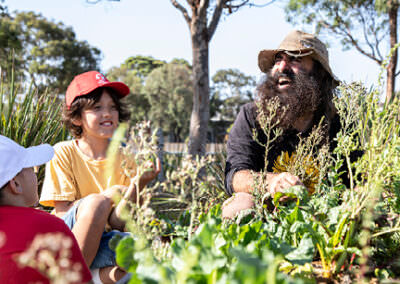
Step 1
Plan
Children can plant fruit and vegetable seedlings and herbs into moist, well-prepared soil all year round. Planning is the key to success. Refer to a planting guide like the Gardenate app to help plan what you intend to grow and when. Are you planting something that people like to eat?
Go through your checklist to ensure you have all the materials you need.
Run through the plan with the children and outline the safety steps involved.
Plant and seed labels are your friend. They will guide you on how, where and how far apart to plant your seedlings. You can use a measuring tape, a stick or hand widths to help.
If you have enough space and plants, you can plan to have your seedlings mature at different times.
Space out the pots onto your bare bed and discuss where they may go. Use planting information and the plant labels to help guide the discussion.
Consider how much space your plant needs when it is fully grown. Will it shade other plants?
Where do you think these plants should go?
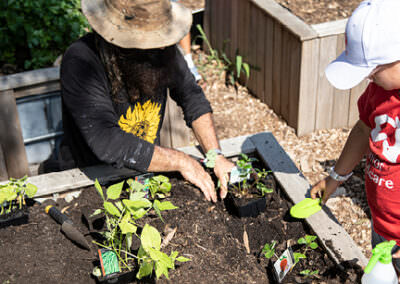
Step 2
Prepare
Fruits and vegetables grow best in rich, well-drained soil so preparing your garden bed is an important step. You may already have good conditions from building your no dig garden bed.
If using raised garden beds, you can prepare the soil in the garden beds. Dig the soil often to break up the clods (clumps), adding decomposed organic matter such as compost to improve the soil’s quality, drainage and moisture, and reducing the need to water.
To give the plants a head start, children can also add in a manure mix and well-rotted compost into the top 15cm of soil.
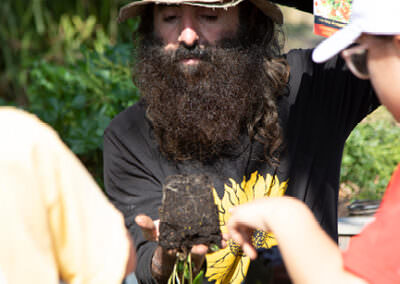
Step 3
Planting
You will need to obtain plants for your food garden. These can be started from seed, grown from cuttings, or purchased as mature plants.
Whilst you are waiting to plant, ensure that your seedlings are watered and in the shade, especially if it is a hot day. Overnight, the plants may need to be protected from pests so keep them under cover. If your seedlings have been grown indoors, they will need some ‘hardening off’. To help your plants acclimatise, you need to place the plants outdoors in small steps over a few days or weeks.
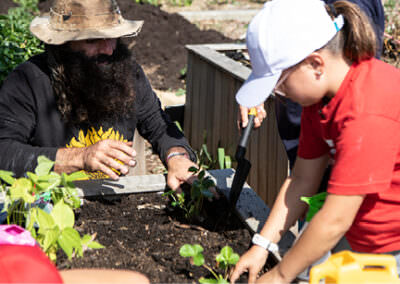
Step 4
Monitor and care
Now that you have completed your planting, use the activity sheet to draw a map and list your plants. Create rosters and tasks to share caring for your food plants with your Junior Landcare team.
Water all the crops to keep them moist on a regular basis. Tend to the garden by mulching and weeding regularly.
Refer to the Growing healthy plants using natural pesticides learning activity for guidance if you encounter sap-sucking insect damage on your food plants.
Extension Activity
Now that you have planted out your food garden, design labels to create signage for the garden and the plants. What information will be important on your label? How can you decorate and make your signs attractive?
Are there some plants that you can eat without growing in soil? Can you design a method to growing edible sprouts?
Curriculum and Framework Links
SCIENCE
Year 2: ACSSU030, ACSHE035
Year 3: ACSSU044, ACSIS054
Year 4: ACSHE062, ACSIS064
Year 5: ACSHE083
Year 6: ACSSU094, ACSHE100
Year 7: ACSHE120
Year 8: ACSHE135
HUMANITIES AND SOCIAL SCIENCES
Year 2 : ACHASSI042
Year 3: ACHASSI052, ACHASSI059, ACHASSI060
Year 4: ACHASSI080, ACHASSK088, ACHASSK090
Year 5: ACHASSI102, ACHASSK120
Year 6: ACHASSI122, ACHASSI130
DESIGN AND TECHNOLOGIES
Year 2: ACTDEK003
Year 3 & 4: ACTDEP017
Year 5 & 6: ACTDEP019
Year 7 & 8: ACTDEK032
HEALTH AND PHYSICAL EDUCATION
Year 2: ACPPS018, ACPPS022, ACPPS023
Year 3 & 4: ACPPS036, ACPPS040, ACPPS041
Year 5 & 6: ACPPS054, ACPPS059
Year 7 & 8: ACPPS073, ACPPS078
ETHICAL UNDERSTANDING
Exploring values, rights and responsibilities
PERSONAL AND SOCIAL CAPABILITY
Social awareness
CROSS CURRICULUM PRIORITY
Sustainability
MY TIME, OUR PLACE: FRAMEWORK FOR SCHOOL AGE CARE
Outcome 2 and 4
Reference List
ONLINE RESOURCES
Download the Gardenate app or use the Gardenate website to help determine the timing, spacing, and other compatible plants required for your climate zone.
Refer to this crop rotation information to help keep the soil and food crops healthy.
WATCH
ABC Gardening Australia has some great points in Making Perfect Vegie Soil on preparing the best soil conditions for growing vegetables. 4 minutes.
Mulch – which one and when to use it has some specific tips on how to mulch effectively in the garden and reduce weeds and water loss and insulate the soil. 6 minutes.
Just for Kids
Check out our fun activity Make your own seedling pots
We value your feedback
When you have finished this learning activity, please tell us what you think with our survey.
Your feedback will help Landcare Australia improve the activities in the Junior Landcare Learning Centre.
Why not try one of our other Junior Landcare learning activities?
Love Letters to the Land
Biodiversity|First Nations Perspectives|Food Production|Waste Management
Creating a food garden: vision
Food Production
Creating a food garden: installing a no dig garden bed
Food Production
Creating a food garden: harvesting
Food Production
